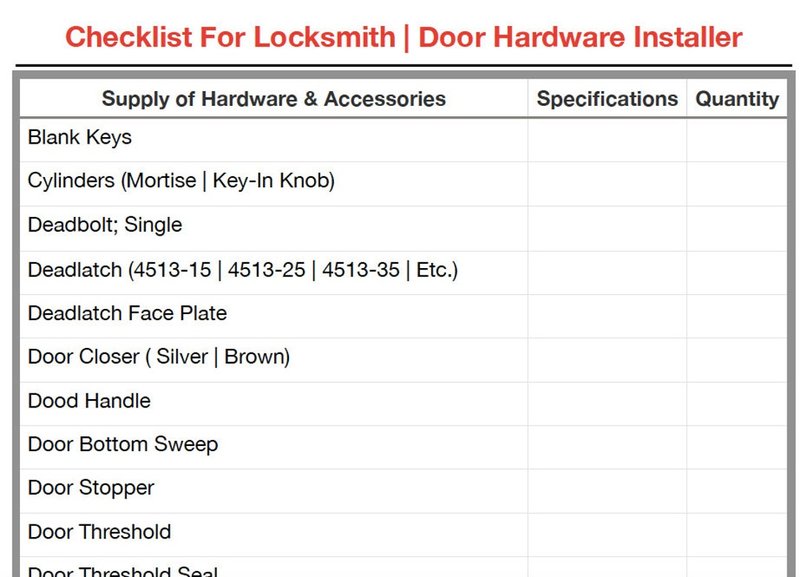
Imagine your door hardware as a well-oiled machine. Each part contributes to the overall performance, and neglecting one component can lead to frustrations down the line. So, let’s sip on our coffee and explore the best annual maintenance checklist for all interior door hardware to keep your doors functioning like new!
1. Inspect Your Door Hardware
Before diving into any repairs or cleaning, start with a thorough inspection of all the interior door hardware. This includes door knobs, handles, locks, and hinges. Check for any signs of wear and tear, like rust, loose screws, or chips in the finish. It might help to have a flashlight handy for those hard-to-see areas.
Here’s the thing: once you spot any issues, you can address them before they escalate. For example, a lock that sticks can become a security concern if not fixed quickly. Consider the age of your hardware. Older components may need replacement sooner than modern ones. It’s smart to jot down any findings to keep track of what needs attention.
2. Clean All Door Hardware
After your inspection, it’s time for some cleaning. Dust and grime can build up quickly, affecting both appearance and function. Start by removing any loose dust with a soft cloth. For deeper cleaning, mix a mild soap with water, dip a cloth in the solution, and wipe down the hardware.
Make sure to pay special attention to areas like the grooves of door handles and around locks, where dirt tends to gather. For stubborn spots, a toothbrush can be a great tool to gently scrub without scratching. Once cleaned, dry everything thoroughly—moisture can lead to rust or corrosion on metal parts.
Cleaning Supplies
To keep things easy, here’s a quick list of supplies you might need:
- Soft cloths
- Mild soap
- Water
- Toothbrush
- Duster
3. Lubricate Moving Parts
Now that everything is clean, it’s time to lubricate those moving parts. This might be one of the most critical steps in your annual maintenance checklist. Use a silicone spray or a graphite lubricant for locks and hinges. Avoid using oil-based lubricants, as they can attract dirt over time.
To apply, just spray or apply a small amount to the moving parts, then work the hardware back and forth. You should immediately notice smoother operation. Honestly, there’s something satisfying about a door that opens and closes silently, don’t you think?
4. Tighten Loose Screws and Fasteners
Next up, grab your screwdriver to check for any loose screws or fasteners. This is especially important for doorknobs and hinges. A loose handle can lead to misalignment, making your door harder to open or close.
Go through each door, tightening screws as needed. If you find any stripped screws, consider replacing them. It’s an easy fix that can save you future headaches. Remember, a little bit of maintenance now can prevent bigger problems later.
5. Test Locks and Latches
Locks and latches are vital for keeping your home secure, so don’t skip this step! Test all your locks to ensure they’re functioning smoothly. If a lock is sticky or won’t turn, it might be time for some lubricant or even a replacement.
If you notice that a lock is particularly stubborn, consider checking the alignment of the strike plate on the door frame. Sometimes, simply adjusting the alignment can make a significant difference. A lock that works well contributes not only to safety but also to your peace of mind.
6. Evaluate Door Alignment
While you’re at it, take a moment to check the overall alignment of your doors. An interior door that’s out of alignment can cause issues like gaps or difficulty in closing. You might be wondering, “How do I know if my door is misaligned?” Look for signs like a door that scrapes against the frame or doesn’t latch properly.
If you find any misalignment, it’s often an easy fix. Loosening the hinge screws and adjusting the door slightly can typically solve the problem. Just make sure you don’t over-tighten the screws afterward.
7. Consider Replacement If Necessary
After all your checks and maintenance, you might find that some hardware needs a little more than just TLC. If you’ve got a doorknob that’s cracked or a lock that’s constantly failing, it might be a good idea to replace it.
When choosing replacements, consider modern hardware that adds both function and style to your home. A sleek new handle can enhance your decor while also providing better security. Plus, with all the options available, you can pick hardware that reflects your personal style!
8. Document Your Maintenance Routine
Lastly, it can be incredibly helpful to document your maintenance routine. Write down what you checked, cleaned, or replaced, along with the dates. This will help you keep track of what needs to be done every year and when.
By having a clear record, you also make it easier if you ever need to troubleshoot a specific issue, or if you just want to impress your friends with your super-organized home maintenance skills!
Regular maintenance of your interior door hardware may not seem glamorous, but it’s essential for the smooth running of your home. With this comprehensive annual maintenance checklist, you can ensure your doors operate effortlessly, providing you with comfort and security.
Follow these steps, and you’ll keep your door hardware in tip-top shape, saving yourself from hassles down the road. So, grab your tools and get started—your doors will thank you for it!
